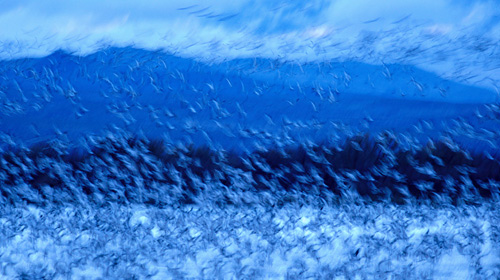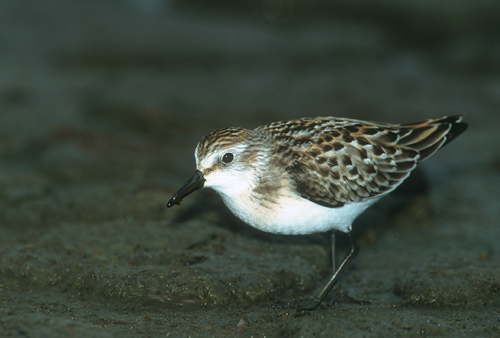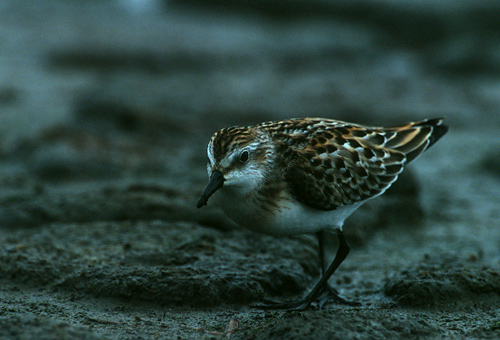U.P. TRIP
REPORT
I
just returned from a wonderful trip to Michigan's Upper
Peninsula (U.P.) It was a strictly-for-fun trip
with friends
David Vore of Flint, Michigan, and Todd Gustafson of Chicago.
We photographed fall color,
mushrooms, turkey-tail fungi,
chipmunks, and waterfalls. David, who has photographed in the
area for years,
was our guide. In spite of the fact that the
color was not yet at peak (2002 was way late compared to most
years),
and in spite of the fact that it (uncharacteristically)
rained heavily on and off for several days, I had an incredible
time
and exposed more than 40 rolls during only six days of
photography.
Amazingly,
I did not photograph a single bird. We did see a Solitary
Sandpiper that was photographable, and on
our
most spectacular morning, we had two Tundra Swans fly right at
us, lit by early morning sun with a background
of blackish-gray storm clouds. Even though we were all
doing abstract reflections with long lenses at the time,
nobody got a frame off as we were all using mirror lock and
self-timer! Ouch, that hurt....
In
any case, I felt a sort of a rebirth, (as a nature photographer)
on this trip, and was so impressed that I have
decided to lead
a nature photography Fall Color IPT to the U.P next October
(dates to be announced) with David Vore
as our location guide.
If you think that you might be interested, shoot me an e-mail.
(I will be sharing some of my
favorite images in a future
Bulletin when the IPT details will be announced.
As friends, we did lots of viewfinder sharing, and both David
and Todd were pleased by the images that this
bird photographer
"saw." My creative vision allowed me to come up with
compositions and concepts that some
others might not "see."
When asked how I do that, I said, "I just make a habit of
looking everywhere, moving around
to change my perspective,
and noticing the colors and patterns that catch my eye or excite
me. Then I decide which
lens to use, exactly where to stand, and
exactly where to point the camera. Lastly I take care of the technicals and
push the shutter button. Though I had the 500mm
IS lens with me, I did 90% of my work with the Canon 28-135 and
100-400 IS zoom lenses and the Canon 180mm macro lens (with each
of those lenses always mounted on a
Gitzo 1325 CF tripod and a
Linhoff ballhead).
BAA CRITIQUING SERVICE
BIRDS AS ART now offers an Image
Critiquing Service. You can have your best images critiqued by
yours truly:
10 slides for $35, 20 slides for $60. (Checks,
made out to "Arthur Morris" and sent with the images are
preferred;
Paypal
is OK.) Slides must be numbered on the slide mounts (and
return postage and mailing materials must be included).
Slides must be in archival slide pages, the ones that hold
20 transparencies. Original slides are greatly
preferred
as it is near-impossible to judge the sharpness of dupes. No
slides will be removed from the slide pages.
I will send an
honest, no-holds-barred critique via e-mail with the slide
reference numbers included. If I think it's great,
I will say
so. Digital or film shooters may elect to send scans on a CD.
Here too, the images should be numbered.
Be sure to include
your e-mail address and return postage and mailing or Fed-X
materials. By sending slides for
critiquing you agree that
BIRDS AS ART will not be held responsible for loss or
damage. Unless time is not an
issue, it is best to e-mail first
to check my upcoming schedule before sending images. Send
images or CDs to:
Arthur Morris/BIRDS AS ART PO Box 7245
(via US Mail) 4041 Granada Drive (via courier) Indian Lake
Estates, FL 33855.
(tel: 863-692-0906)
FORT WALTON BEACH, FL PHOTO EVENT
I will be doing three programs, including the Friday night
keynote, "A Bird Photographer's Story,” for the Beaches
of Fort
Walton Photo Safari (October 25-27, 2002) sponsored by the
National Audubon Society. Please note
that though the
attached indicates fees for the various programs and
field workshops, EVERYTHING, thanks
to the generosity of
Eagle Optics, IS FREE. All that you need to do is
register.
Here
is a link to the basics:
http://www.nanpa.org/news/audubon_2002.html
If
you have any additional questions, please contact Susan Loredo
at
sloredo@audubon.org
or phone her at
212-979-3101. Thanks. (There is additional contact INFO at the
NANPA link.)
If
you attend and learned about this event through this BAA
Bulletin, be sure to stop by and say, "Hi."
THANKSGIVING
AND THE BOSQUE (and other) IPTs
For the past several years, I have hosted a Thanksgiving Day
Buffet lunch at the historic Val Verde Steakhouse in
Socorro for
photographers and friends. The food is incredibly good, with
tons of turkey and yams and all the fixings
as well as tablefuls
of great desserts. This year's lunch will be at 12:30 pm. All
are invited. Bring 70mm dupes
or small prints to show off. I
hope that you can join us.
The fall Bosque 3-Day IPTs are filling nicely, but there are
openings on each of these IPTs (5, 5, and 2 respectively
for the 11/18-20, the 11/24-26, and the 11/30 to 12/2
Photo-Tours). Note: My skilled teaching assistant,
Ellen Anon,
will be with us on the first two segments only. She is
especially helpful to those fairly new to bird photography, and
is
an expert in all areas of digital photography. So
far, and somewhat inexplicably, not a soul has registered for
the
Post-NANPA Bosque IPT (2/25-27/2003). If you would
like to join me, please do send a deposit check now.
At some point in the future, I will cancel this IPT if nobody
has signed up, but, as from the beginning, this and
all other IPTs will run with only a single participant.
Click here for details:
IPT Schedule
The
post-Christmas SW Florida 3-Day IPT (11/27-29/2002) is nearly
full with only three openings.
The San Diego 5-Day IPT
(1/8-12/2003), with its spectacular breeding plumage Brown
Pelicans and
their fire engine red bill pouches, has five
openings. Click here for details:
IPT
Schedule and
then scroll down.

Image copyright 1998 Arthur Morris/BIRDS AS ART
Snow Geese, Blizzard in Blue Bosque Del Apache NWR, San
Antonio, NM
Canon EF 400MM F/5.6 L Lens and A2 body.
FLASH
AS MAIN LIGHT
I am often asked when and how I use flash as main light.
(Note: this topic is covered adequately in Chapter Four,
"On Matters of Light" in "The Art of Bird Photography.")
What follows is a summary of that information with some
additional new details.
When
shutter speeds drop below 1/60 of a second when using big
lenses, especially with teleconverters,
I employ the flash as
main light technique. The reason for this is that (even with IS
lenses) it is easier to make
sharp images with flash as main
light because the effective shutter speed are measured in many
1/1000ths of a
second (the duration of the flash). My very
great preference is to work in manual mode. In most cases, I
will
underexpose the background by 1 to 1 2/3 stops and set the
flash to "0" compensation, in other words, full flash.
In most
cases, our modern smart flashes will expose the subject
perfectly. When using flash as fill, we always
reduce the flash
to some degree, usually between 1/3 and 1 /13 stops (with
greater reduction for digital photography).
With big lenses, I
always use a Better Beamer to increase the effective range of
the flash and avoid wasting light
and thus battery power; see
Better Beamer for
Better Beamer info.
It's
that simple. Do understand that when using flash as fill, where
we want the ambient exposure to be correct
as if we were not
using flash,
the
image will look pretty good if the flash does not go off. With
flash as main light,
however, if the flash does not fire, the
image will be grossly underexposed. When I was up in Boston at
Parker
River NWR, we had to deal mostly with dark drizzly
days--the ideal time to think "flash as main light."
Below you
will find one image where the flash fired, and one
where (obviously), this flash did not fire.
For most folks,
seeing these examples reinforces their understanding of the
flash as main light technique.

Image copyright 2002 Arthur Morris/BIRDS AS ART
Juvenile Semipalmated Sandpiper, Parker River, NWR, MA
Canon EF 500mm F/4L Lens, 2X TC, EOS 1v, 550 flash, flash as
main light at zero.
Provia F-100 pushed one stop.
Notice that with the background proximal to the subject, the mud
in not rendered black, because the flash
effectively lit the
background. Had I gotten right down on the ground, the
now-distant background would
have been rendered as black because
the flash falls off with the square of the distance.

The
details here are the same as for the above, except that the
flash did not fire. Note the horrific greenish cast.
In the
image above, the flash has restored the film's color balance.